6 Reasons Why You Should Watch The Last Stand: A Kim Jee-Woon Retrospective
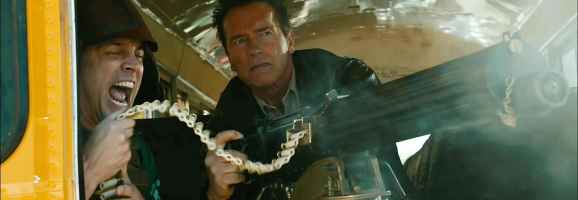
You’d be forgiven for saying, “who?” when presented with the name Kim Jee-woon, which is exactly what I did when I found out that he was the director of The Last Stand, the long-awaited return of legendary Austrian tree trunk, Arnold Schwarzenegger. Why has Hollywood entrusted the grand return of a Hollywood icon to this guy I’ve never heard of?
Little did I know that I’d actually already seen a film of Kim Jee-woon’s without knowing it. A Bittersweet Life (2005) is a stylish and violent gangster flick that deserves to be remade just so that shallow western audiences will have the patience to sit through it, and I’ll be able to say, “Oh, remember that film where the guy digs himself out of a shallow muddy grave in the pouring rain and then beats the living genitals off of a warehouse full of baddies with a flaming torch?” without receiving a roomful of blank faces.
Well, in my favourite impulsive fashion, I’ve spent the last two weeks watching Kim Jee-woon’s entire feature filmography, and I can see now why he is a superstar director in South Korea with an outstandingly varied portfolio of movies under his belt.
The Last Stand is out now in cinemas and not performing even a fraction as well as it should be doing, critically or commercially. Well, I think you should go and see it now, and the reason is Kim Jee-woon. Why? Let’s find out.
6. He’s Korean
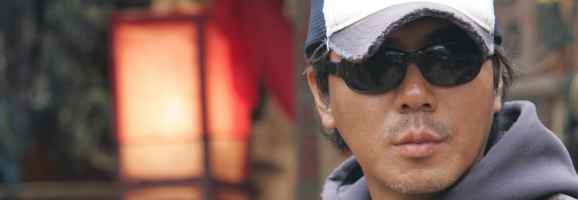
Far be it from me to suggest that one’s nationality and cultural background is a bona fide guarantee of a fantastic product, but let’s face it, South Korea is in right now. Even beyond the realms of cinema, we’re witnessing a cultural renaissance in the making. North Korea and its almost comically evil regime, headed by cabbage patch kid Kim Jong-un, is exhaustively attempting to escape from the 20th Century, whilst South Korea is busily leading forth the charge towards the 22nd Century. Consider everything from cutting-edge electronics (like LG, who recently won the race to release a 4K resolution OLED TV), pop music (I challenge you to find one person who’s yet to hear PSY’s Gangnam Style), gaming (such as NCSoft, who developed the critically adored Guild Wars, and the hugely popular Lineage MMORPG series, and let’s not forget Korea’s superstar eSports celebrities, kicking the arse of the West at Starcraft), and tourism, where Seoul is fast becoming the new Tokyo for Asiaphile travellers. South Korea has its fingers in every noodle bowl, so it’s no wonder their film industry exports so well.
Korean cinema has a distinct flavour to it, often very dark and morbid whilst somehow maintaining an intact sense of humour, typically rooted amongst its dark themes. Consider a film such as Park Chan-wook’s Oldboy, a film so utterly absurd it should never have plucked so many emotional strings. A film with such a devastatingly twisted ending, it’s a testament to masterful direction that it managed to take itself so seriously. The best of Korean cinema is this beautifully paradoxical concoction of tragedy and comedy teetering on the brink of mutual annihilation, held in perfect equilibrium by the artists of its industry. Of course, sometimes, this dangerous mixture does indeed result in self-destruction; have a look at my scathing review of Say Yes if proof is required.
Kim Jee-woon’s films are the epitome of this stark contrast. Hopping from genre to genre like a flea in a wig shop, he has proven himself to be one of the most flexible names in the business. His dark humour is bang-on what we have come to expect from Korean movies. Hollywood needs more Korean directors, and I for one am pleased for Kim Jee-woon to lead the charge.
5. He’s Jack-Of-All-Genres
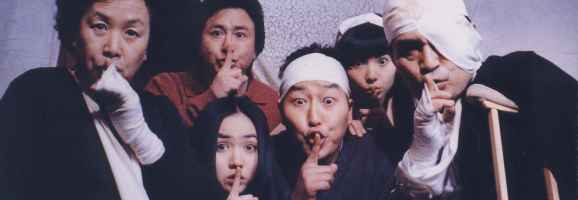
If genres were bunny-girls, Kim Jee-woon would be Hugh Hefner, such is the diversity of his filmography. His first two feature films, A Quiet Family (1998) and The Foul King (2000) were straight-up comedies. The Quiet Family came brandishing the obligatory dark Korean twist, as a struggling family take on a remote lodge on a popular hiking trail and end up somehow accidentally killing each individual guest. Before long, they end up with a mass grave under their house in a desperate attempt to hide the slaughter from the increasingly suspicious local police force. The film piqued the interest of prolific Japanese director, Takashi Miike, who remade it as the far more eccentric Happiness of the Katakuris (2001).
The Foul King is a sports comedy, and probably the only film about Korean wrestling that you will ever see in your lifetime. Fortunately, it’s a fantastic laugh, and kept me thoroughly entertained throughout, perhaps in part owing to the presence of long-time Kim Jee-woon collaborator, Song Kang-ho, who has a deadpan look of Stan Laurel calibre.
Kim Jee-woon later broke out the supernatural with A Tale Of Two Sisters (2003), a haunted house horror with a twisted story that recalls films such as The Sixth Sense and The Others. This is a contender for the darkest of Kim Jee-woon’s movies, although it would have a job to do if it wanted to be more disturbing than I Saw The Devil (2010), a slasher-horror revenge flick with sickeningly realistic murder and rape sequences, and without any doubt the movie of his least accessible to a mainstream audience. Not for the faint-hearted. Or the squeamish. Or for paranoid women who walk home alone from work late at night. You’re gonna die.
I’ve also mentioned A Bittersweet Life (2005), a memorable blood-splattered gangster movie with some fantastic action sequences, characters and set-pieces that take a generic tale of vengeance and allow it to bloom into something much more special. Korean heart-throb, Lee Byung-hun, also a regular collaborator, dominates the action sequences here.
It is this genre-hopping that has proven Kim Jee-woon as a Jack Of All Trades of Korean film-making, and this statement is not intended to diminish from his ability in each specific genre. He is a man who clearly has a great deal of love for all of cinema, and has expressed a strong desire to drive forward Korean cinema for both its domestic and international audiences.
I can already feel the figurative rotten tomatoes flying towards my face as I’ve failed to mention arguably the most famous and well-loved of all of Kim Jee-woon’s movies, and for that, let’s move onto the next section…
4. He Loves the Western
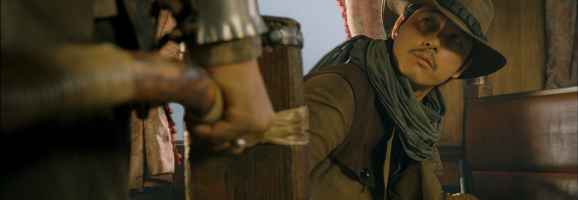
The Last Stand is a Western, in the most classic sense. A Sheriff and his deputies defending a town from a fast approaching gang of bandits is a tale as old as the genre itself.
I couldn’t possibly write a feature on Kim Jee-woon without mentioning The Good, The Bad and The Weird (2008). So-called “Eastern-Westerns” are certainly nothing new to the film world, in fact, in Japan, the term “Sukiyaki Western” describes this very genre. The Good, The Bad and the Weird (I’ll call it GBW for short) is one of the most imaginative, exciting and unique films I have ever seen. An “analogue” production favouring practical sets, effects and stunts, it evoked childhood memories of movies at the height of practical special effects, the likes of Indiana Jones, where magnificent sets were built and filled to the brim with costumed extras.
Part of its charm is the anachronistic nature of its setting. A western complete with wide-brimmed hats, six-shooters and steam trains, suddenly reveals a world where bandits escape train robberies with motorcycles and sidecars, and the unwanted occupiers are Japanese and not British. Kim Jee-woon has taken the western genre and has fit it around 1940’s Manchuria, traditionally sovereign Korean territory that was occupied by the Japanese during the Second World War. The result is a riveting mash up of East and West, like wasabi fried chicken. The best thing to have ever been invented, ever.
Many will disagree that GBW is Kim Jee-woon’s greatest film, and it certainly isn’t his most critically acclaimed. It is however testament to his ability not just as a filmmaker, or a screenwriter, or even a director, but as a creator. Given a Hollywood-sized budget, the prospect of where his imagination will take us is positively mouth-watering. Like wasabi fried chicken.
Through no effort of its own, like many “foreign” (non-English) productions do, South Korean cinema tends to be exported as “arthouse”. Korean films are given limited if not completely non-existent theatre releases in the USA and Europe, and often avoided by the mainstream consumer, who, quite frankly, do not have the patience to sit through a subtitled movie (and avoid dubbed movies like they’re herpes if they know what’s good for them). GBW appears to be one of few non-English films that get marketed for the mainstream. It did receive a limited release in the US with modest success, but ultimately its disc-release was the focus, and was snazzed-up beyond the usual world cinema affair, with a colourful sleeve and attractive design, targeted at the everyday consumer. And that is exactly the type of movie it is; a fun, high-octane blast that deserves to be loved.
3. His Action Scenes Rock
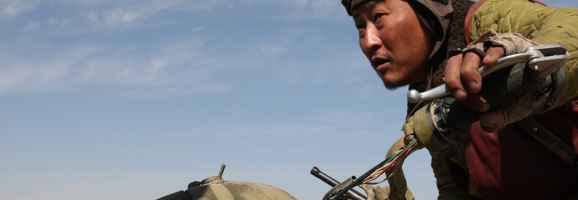
When it comes to top quality action, Kim Jee-woon has planted a proverbial firecracker in the underpants of Korean cinema. So arse-blisteringly good are the best of his action sequences that Hong Kong should be green with envy. Never is CGI used to augment (ie. ruin) great action in his movies, and the majority of the stunts are performed by the actors themselves, keeping them grounded within the realms of reality. Lee Byung-hun is generally the frontrunner of badassery amongst Kim Jee-woon’s films, doling out severe and vengeful punishment throughout A Bittersweet Life’s brawling and gunplay, I Saw The Devil’s sadistic and poetic homebrew justice, and GBW’s bang-bang-vroom-vroom-yee-haw-stabbity-stabbing.
I Saw The Devil takes the predatorial hunt of a typical slasher movie and turns it on its head, as Lee Byung-hun’s bereaved government agent stalks his wife’s killer, blurring the lines between monster and hunter. Along the way we’re treated to a Mortal Kombat’s-worth of brutal pugilism, almost unanimously going in Lee Byung-hun’s favour as he subjects his psychopath prey (and a few other “innocent” psychopath suspects) to increasingly brutal retribution.
A Bittersweet Life’s greatest action sequences have to be a contest between two scenes. The first is a mid-movie melee between Lee Byung-hun’s morally fibrous gangster as he digs himself out of a muddy grave and sets upon a roomful of goons in a warehouse with a flaming torch. The second is a climactic Tarantino-esque gunfight in which every participant gets shot about a million times, and everyone ends up swimming in a shallow pool of claret on the floor, tiredly waving their guns around like slow-motion orchestra conductors.
The absolute cherry on the Kim Jee-woon Cake of Action, however, is the Great Chase sequence in GBW. So loin-moisteningly awesome is this sequence, in which every live character from every damn faction in the entire movie ends up chasing Song Kang-ho’s bandit across the Manchurian wilderness, that I’d be struggling to name any chase sequence I have ever enjoyed more, in my entire film-watching experience. The Japanese army fire mounted machine-guns from the rear of jeeps whilst an army of barbarians on horseback swing hammers around, and rifle-toting cowboys gallop through, picking off men left and right. It is exhilarating, and just about the most bizarre sequence you’ll ever see. I’d have nay been surprised had a Viking turned up on the back of a T-Rex, firing candy-cane shaped dynamite sticks off a head-mounted catapult.
With a tone somewhat similar to GBW (the appearance of Johnny Knoxville kind of guaranteed this), Kim Jee-woon has brought out the OTT action for The Last Stand.
2. He Can Make You Laugh
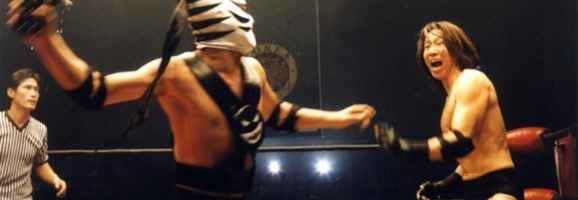
The most obvious examples of Kim Jee-woon’s ability with comedy are in The Quiet Family and The Foul King. The Foul King, in particular, had me grasping my belly and rolling backwards with laughter at regular intervals, particularly during the halfway-point fight sequence, where Kang-ho Song’s businessman-cum-pro-wrestler submits his teammate to a horrendous, unintentionally violent beating.
Even at his most dark and disturbing, Kim Jee-woon can break out the funnies. In I Saw The Devil at one point, the killer psychopath villain of the movie inadvertently happens upon another duo of murderous psychopaths, who, just short of garrotting him, end up stabbed such an atrocious number of times they’re leaking like a nosebleed in a sieve. He opens up the boot only to find a nameless victim of theirs, tied and stiff, and posthumously awards them the title of “a pair of psychos”.
Earlier on in ISTD, during a harrowing and sob-inducing sequence where cops searching the vicinity of a crime scene discover the head of a murder victim, one of the forensic officers carrying the head in a box ends up tripping up and dropping it in the grass, where it rolls around lifelessly towards a grieving father and husband. The scene does not lose its emotional impact because of this ridiculous event. If anything, it reminds us that humour exists at every station of life, however grim and upsetting it may be, and this is something close to Kim Jee-woon’s philosophy.
1. When He’s Dark, He’s Dark
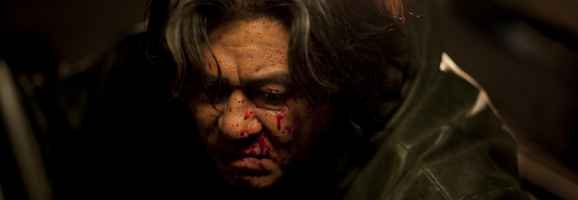
After the aforementioned opening sequence of I Saw The Devil, I had genuine tears queuing up in my eyelids, held back only by the impenetrable wall of virility I possess. Kim Jee-woon dwells for some time on the emotional trauma of the brutal murder and the effect it has on the sanity of Lee Byung-hun’s bereaved husband. Bubbling family members shake with grief as the body enters the incinerator. It is an incredibly moving experience, and had a stronger reaction from me than any of the torture-porn sequences that follow. ISTD depicts murder in a frighteningly realistic way, unlike your standard slash-horror with busty bikini-clad babes having their chesticles popped by masked murderers. Vulnerable women are preyed upon; beaten senseless with hammers and then sliced into pieces in a filthy warehouse.
A Tale Of Two Sisters likewise has its share of darkness, particularly at its ending, which I won’t spoil for those who’ve yet to see it. It is a supernatural horror but surprisingly light on the actual horror, but remains macabre at all times. Rarely does it deliver the heart-punching jolt we’ve come to expect from similar films, and gives the impression it is not after cheap scares from its audience but is playing a twisted game with their expectations. If I were to pick an “odd-one-out” of Kim Jee-woon’s films, this would likely be it, as the humour is not so much scarce as it is completely non-existent.
Even The Good The Bad and The Weird gets its fair share of darkness. A film of similar tone in Hollywood would likely be aimed at the 12A/PG-13 audience, with the actions of its psychotic villain suggested off-screen rather than presented in their full, gratuitous glory. The sawing off of a finger on-screen, for example, might be considered unnecessary by some in a film otherwise light-hearted and fun, and in Hollywood would probably have never made it past a producer.
In a nutshell, that is why Hollywood needs more Korean directors like Kim Jee-woon. They play by a different rulebook. In a cinematic climate where remakes and reboots are the bee’s bollocks, an injection of originality from overseas is what is needed to set a new Hollywood paradigm. The Last Stand might not be a high-art love letter to the medium of film, but it is a solid action comedy that deserves to be seen, if only to allow creative minds like Kim Jee-woon a foot into the American film industry. Give it some thought, anyway, folks.
The Last Stand is out now in movie theatres worldwide.
What do you think? Leave a comment.











You make me want to see a few of the films mentioned.
thanks
My personal favourites are Good, Bad & Weird, Bittersweet Life and Foul King, although if you can stomach it, I Saw The Devil is worth a watch too.
Your tomfoolery does not hide the fact that your articles are some of the most purely entertaining that I have ever read. Tale of Two Sisters had me almost dropping some fruit in my looms at several points – particularly the “slow-moving figure at the foot of the bed” scene. Kim Jee-Woon is pretty consistent in terms of quality, which makes him a very impressive talent. I will try to make time for The Last Stand this week.
True, there were a few scary moments like that, although most of the horror for me came from the sheer unpredictability of what was going on. The “What The Fuck” factor basically.
Interestingly there was one anthology movie I missed off called Doomsday Book in which he directed a segment. It’s a sci-fi flick, have you seen that?
I haven’t seen it unfortunately, so I will be adding that to the watch list along with Foul King, which sounds arse-bustingly funny
Oooh yes, thank you for showing your praise to the almighty Kim Jee-Woon! Hope that we will stay here for another movie, while I would not mind another Korean ISTD!
As I understand it, his next project is a live action version of the anime, Jin-Roh!
WHAT! What do we know about this project? If there should be anyone, it should be you writing about it.
What a splendid idea! I will do some digging and present my findings here. Watch this space!
Very informative, BitTorrent here we come!
(lol) Begin with I Saw The Devil. Its nuuuts!
Mate, thank you for pinpointing how frikin awesome GBW is! Thank you!
It is indeed incredible!
Do not hate me… but, this was my least favorite Jee-Woon movie! Not bad at all but I am a long time freak of his movies so was expect more.
Although I know I’m making my best efforts to persuade people to watch this, admittedly I’d tend to agree. This wasn’t a review of The Last Stand so much as it was a rallying cry for Kim Jee-Woon, and by extension Korean cinema as a whole.
He’s one of the most consistent Korean filmmakers working today. He really is a jack of all trades and can work within any genre. I Saw The Devil was one of the most physically and emotionally exhausting movies I have ever seen. It doesn’t give the viewer a chance to breathe and it’s absolutely brutal. Great article!
YES YES YES! I was biting my nails through the film, without a minute of break.